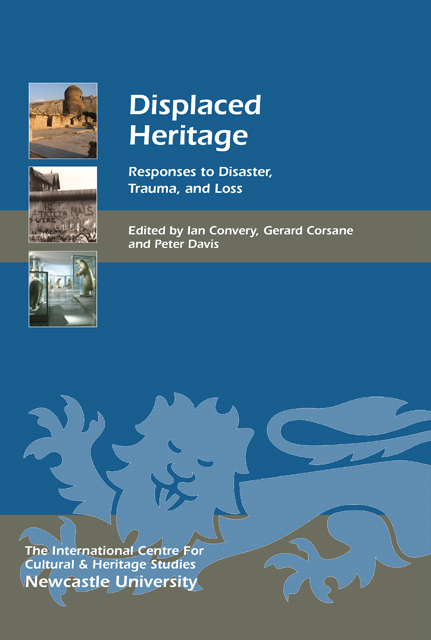Book contents
- Frontmatter
- Contents
- List of Illustrations
- Acknowledgments
- List of Abbreviations
- Preface
- Introduction
- Displaced Heritage: Histories and Tourism
- Displaced Heritage: Trauma, Confinement and Loss
- Displaced Heritage: Lived Realities, Local Experiences
- Displaced Natural Heritage
- Endpiece
- List of Contributors
- Index
- Heritage Matters
27 - After nanoq: fl at out and bluesome: A Cultural Life of Polar Bears: Displacement as a Colonial Trope and Strategy in Contemporary Art
Published online by Cambridge University Press: 24 February 2023
- Frontmatter
- Contents
- List of Illustrations
- Acknowledgments
- List of Abbreviations
- Preface
- Introduction
- Displaced Heritage: Histories and Tourism
- Displaced Heritage: Trauma, Confinement and Loss
- Displaced Heritage: Lived Realities, Local Experiences
- Displaced Natural Heritage
- Endpiece
- List of Contributors
- Index
- Heritage Matters
Summary
nanoq: flat out and bluesome is a project by Snæbjörnsdóttir/Wilson that began as a survey of displaced taxidermic polar bears in the UK conceived with a view to restoring specific and discrete histories to relics whose purpose had hitherto been generic and symbolic.
Since completion of the project nanoq: flat out and bluesome (2006), the photographic archive from the survey has gone on continuous tour of a host of zoological, maritime and polar museums in northern Europe, including those within the Arctic region itself, such as in Long-yearbyen, Svalbard and Tromsø, Norway. One of the prime ambitions of the project is to bring singularity to the remains of specimens whose individual, cultural purpose has been to act as representative for a species – and sometimes, even more generically, its environment. In addition there are those specimens in private hands which function as company mascot, conversation piece and inevitably, hunting trophy.
Beginning my discussion on the subject of animals and their presence in art from this very work [nanoq] is important, as [it] could, from multiple perspectives, be understood as a quintessential work thus far produced within the discourse of human–animal studies. […] Snæbjörnsdóttir and Wilson have developed an international reputation for the creation of conceptual works of art that simultaneously embody the core and transcend the boundaries of human–animal studies’ strictly academic discourse in order to communicate to wider audiences. (Aloi 2012, s74)
For the artists, nanoq first and foremost concerns the issue of representation and how representation itself must always be a depletion and distortion of that which is represented. Historically, by removing the bears from the arctic and populating museums with these and similar colonial plunder, the will to construct self-congratulatory narratives through the display of the ‘tamed wild’ is clear. In 2004, when ten polar bear specimens were purposely displaced again for the eponymous installation at Spike Island in Bristol, their mutual effect upon each other was to simultaneously cancel out their representational and iconic currency and render visible as counterfeit the promises they had been called upon to convey. This chapter explores these contradictions and other readings of the project, of which Hunterian Museum director Dr Sam Alberti has stated led UK zoological museum curators to reappraise their approach to the collections in their charge.
- Type
- Chapter
- Information
- Displaced HeritageResponses to Disaster, Trauma, and Loss, pp. 293 - 302Publisher: Boydell & BrewerPrint publication year: 2014



